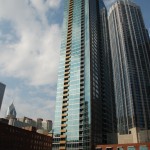Several years ago, I attended a symposium headed by Mr. Rick Fedrizzi, President of the U.S. Green Building Council (http://www.usgbc.org/), regarding the LEED green building program. During the symposium, the environmental effects of construction, housing and coal powered plants were the topics of discussion. I saw a definite value for reducing our carbon footprint during the construction and occupancy phases using the “less is more” philosophy. In the past few years, I have noticed that more new construction projects have sought out a LEED certification.
While I don’t claim to be a LEED expert, I have done some basic research on the subject and how my industry, unbonded post-tensioned concrete, factors in. I believe that unbonded post-tensioned concrete can help some mid-rise and high-rise office/residential buildings received a higher LEED rating.
BUILDING HEIGHT
The potential for a reduction in the building height (and floor-to-floor height) is one key benefit that Unbonded Post-Tensioning has over Structural Steel. The Post-Tensioning Institute issued a technical bulletin which compares the savings in building height: a typical 10-story structural steel building has a height of 125’ whereas a typical 10-story post-tensioning building has a height of only 108’. The impact of the 13.6% reduction in vertical height is obvious – the quantities of all vertical elements will be reduced.
When compared to a Conventional Rebar slab, an Unbonded Post-Tensioning structure can function with thinner slabs and smaller columns. The Post-Tensioning Institute issued a technical bulletin which showed a 16% reduction in concrete with a post-tensioned residential building (excludes foundation). Also, the weight of the steel (post-tensioning tendon and rebar) inside the slabs/beams was 20% less in the post-tensioned structure versus a conventional rebar structure. Finally, the vertical height was reduced by 2% in the post-tensioned building.
With a reduced building height due to unbonded post-tensioned concrete, there are potential savings for the following:
Construction
- Piping for Mechanical, Electrical/ Telecom/Security, Plumbing, Fire Protection, etc.
- Facades with Curtainwall, Precast, Masonry, etc.
- Concrete Columns and Shear Walls
- Elevators, Metal Stairs, Construction Hoists/Cranes
- Reduced floor-to-floor height can reduce material for interior finishes (drywall, etc.)
- Reduced freight, CO2, pollution, labor, manufacturing, etc.
Operational Life-Cycle Savings
- The building will cast less of a shadow on the ground. This can allow grade-level vegetation to receive more sunlight. Therefore, landscaping costs and water usage for irrigation can be reduced.
- There will be a reduction in the energy required to vertically transport liquids (water), gases, cooled air, people, etc. Ultimately, this should reduce the energy bill for the owner(s).
- Quicker evacuation times in case of emergencies for tenants on the upper levels.
- Reduced floor-to-floor height and volume can reduce HVAC costs within units.
In future posts, I will talk about Building Weight, Quicker Construction and other LEED items.
Post Tensioned Concrete and LEED (part 2)
Post Tensioned Concrete and LEED (part 3)
– Neel Khosa, AMSYSCO Inc.
Copyright © 2009 by AMSYSCO, Inc. All rights reserved.











